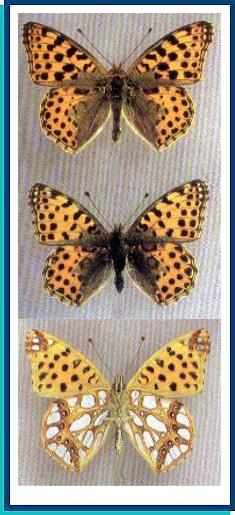LEPIDOPTERA
N Y M P H A L I D A E Swainson, 1827
ISSORIA Hiibner, [1819]
Issoria lathonia (Linnaeus, 1758)
Issoria lathonia (Linnaeus, 1758)

• TYPE LOCALITY. «Europa» [Sweden].
• SYNONYMS. ualdensis (Esper, [1804]); saturata (Rober, 1896); hungarica (Aigner-Abafi, 1906) ;jlorens Verity, 1916; sheljuzhkoi (Stauder, 1923).
• RANGE. Temperate belt of the Palaearctic Region exclusive of Transbaikalia, the Far East, and the Amur and Ussuri regions.
• DISTRIBUTION AND VARIATION. In view of great migratory activity, division into subspecies is difficult. Individual variability is also insignificant, but the butterflies from the southern parts of the geographical range are noticeably larger. Over the territory considered, solely the nominotypical subspecies is known to occur. From the adjacent Asian territories, the following taxa have been described: isaea (Gray, 1846) (TL: Himalaya); messora (Fruhstorfer, 1909) (TL: Ta-Tsien-Lou); isaeoides Reuss, 1925 (TL: Szetschuan).
• HABITATS AND BIOLOGY. Occurring everywhere, but open dry landscapes seem preferable. Flight period: April to October, in 2, 3 or even more generations. Host plants: Viola tricolor, V. arvensis. In Europe (Eckstein, 1913 and others), Anchusa, Riibus, Onobrychis have also been noted as host plants. Near Novosibirsk (Korshunov, 1996) butterflies lay eggs on seedlings of Persicaria lapathifolia and Stellaria media. All stages hibernating. Butterflies can migrate over large distances.
Photo and text: Guide to the BUTTERFLIES OF RUSSIA and adjacent territories Volume 2. PENSOFT, Sofia - Moscow. 2000